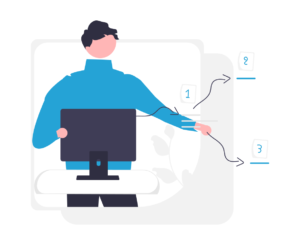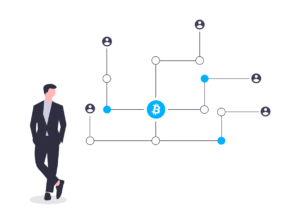
Evolution of Web3 - Challenges and Solutions In 2023
Introduction
Updated: April 7, 2023
The evolution from Web 1 to Web 2 and from Web 2 to Web 3 has been mandatory and brought significant changes in the way we communicate with people, and how businesses were conducted. The changes had been drastic and monumental, with Web 3 growing as the semantic web infused with the right amount of personalization where the web acts almost like a human and can read, categorise and respond like one. Web 3 is thus the third generation of Internet services that would help businesses generate complete, intelligent, open and user-friendly websites.
The biggest advantage with Web 3 is that users can create content, own, control and monetize it using blockchain technologies, NFTs and cryptocurrencies. This generates a correlation between Web3, blockchain technology and meta verse. With Web3, the customer’ chances of making successful online purchases are really high; it positively enhances big data analytics, augmented reality, artificial intelligence and virtual reality. Web 3 is touted to be secure, confidential, private and decentralised when compared to the current Web. And there is no need for intermediaries anymore because with decentralised applications, you don’t use them, because the transactions are more transparent.
Even so, web3 can be a bit intimidating to people because people are still understanding the blockchain technology, and there are some issues and challenges involving the technology.
The Challenges of Web3
As explained above, there is still the fear that entails the widespread adoption of Web3. Check out some of the challenges involving Web 3:
1. Accessibility
The accessibility for Web3 platform is segregated. That means, you might not be able to interact with certain Web3 projects, Dapps and tokens based on where you live, what device you use and the bank you do business with. This is almost like how it was when Web1 first rolled in. A lot of factors controlled the internet then like the equipment you had, the location you accessed the program from, your ISP, even environmental factors. There were language and cultural barriers at the time, and a lot of people couldn’t get access to meaningful content.
Things improved a lot when Web2 rolled in, but there were still some limitations like browser variations, the credit card you owned, your location, etc. With Web3, you can expect something like that blocking the way for a seamless adoption like different technologies, wallets, chains, protocols etc.

With Web1, security was at an all time concern, and the panic levels died down a bit with Web2, when SSL security and two-step authentication systems came into place. The payment systems became more secure and standardized, and companies were able to address security threats and provide more seamless business transactions. With Web3, this still has to improve a lot because standards aren’t very secure yet as the users depend on their wallets to protect their keys. They still need to go through centralized companies to connect to blockchains. Blockchain is still unvetted and unaudited, so there is a chance that you could fall into issues.
3. Speed
You might think that with the technology updates, speed has improved with Web3. Unfortunately, many of the major blockchain networks are still slow when you compare them with the performance of centralized networks. The problems with blockchain can be named as trilemma – the trade-off between scalability, security and decentralization.
4. Storage
Another problem with Web 3 is storage. Data storage on Web 3 isn’t cheap, and can cost thousands of dollars. But there is one advantage with this technology, and it comes in the form of data ownership. Earlier, the user’s data ownership was not in the hands of the user. For example if you had money in a particular game account, you might lose it all once the game manager decides to close the account. But with Web 3, it doesn’t happen that way because the ownership lies with the user.
5. Traceability
The general consensus is that crypto wallets provide a great degree of anonymity. This is because all the transactions are public, and recorded on the blockchain. There is a high degree of traceability since all the actions can be traced back to the owner, and anyone can see and analyse the actions. For example, it would help catch criminals in action – imagine a case where the kidnappers demand a ransom and once the ransom has been paid, the law authorities can actually trace the ransom back to the criminals. Anyone who makes a transaction in the web3 space can be traced. This would probably help in less crimes being committed.
6. Scalability
Scalability is one of the challenges of web 3 adoption. It is a big issue for blockchains and many users refrain from adopting Web 3 because of the blockchain scalability trilemma. According to the scalability trilemma, the blockchain can address only two out of three (security, decentralisation and scalability) characteristics (that can be met by the public blockchain) at a time.
As a result of this, many Web 3 protocols have compromised on decentralisation and security by prioritising scalability. This has caused many Web 3 solutions to be hacked because they were not decentralised enough. Many of the Web 3 applications have shut down too making the users quite unsure, insecure and uncertain.

It is not an easy task integrating all those Web 3 applications, especially when compared to Web 2. Several Web 3 developers maintain client side SDK, a development cycle that demands a lot of time and energy. It’s a time consuming process for application and protocol developers. This makes the application development pipeline really long.
8. The development process itself is complex
The development complexity of Web 3.0 applications is also complex, because the developers need to know the new programming languages, in-depth knowledge of the logic behind each smart contract and additional frameworks too. And if there is even a single bug, the loss could be in millions of dollars in cryptocurrency. And the development time would also increase when you rely on one particular blockchain, especially when there is usage of third-party tools, as the testing, debugging and auditing takes time.
9. Centralized or Decentralized?
We know that decentralization is one of the key aspects of Web 3. But is it really so? While the technology loudly exposes crypto assets, NFTs, DeFi, metaverses and smart contracts you still need Web 2 to make these things work. However, most web3 protocols have not yet fully evolved and they still rely on centralized platforms to iterate faster. So, while all the claims about decentralized protocols and applications are being made, they still need centralized infrastructure.
10. Not very impressive UI and UX
The UI/UX of web 3 is nothing home to write about. Typically, in the Web2 platform the convenience and user-friendliness of these two are definitely what makes them attractive to the users. Web3 still has to be developed in order to be user-friendly and convenient, without sacrificing on security. It is important to develop applications that users will find easy to use.
11.The regulations concerning Web 3 space
One of the solutions that Web 3 space has to see comes in the area of regulations. Different countries have different opinions about Web3, and some of them see the technology as a legal tender. And certain countries like China have banned crypto space. It is important to wait for some time to see how the dust around all this settles. Thus, how the regulations and limitations on crypto turns out is yet to be seen.
The Talk About Web 5
Is there really a talk about Web 5 to counter the challenges posed by Web 3? Can it ensure the development of a new ecosystem that will empower all the users to be in control of their data, while the storage will still be in the decentralized web nodes? That remains to be seen. These web nodes will be personal datastore for holding public and encrypted data. It is yet to be seen whether Web 5 will be able to cover the challenges posed by Web3. But then, it is also worth the wait, we can always see how far Web 3 is innovating and evolving, so maybe there will be a way these shortcomings are met.
Developer teams are focused on building more decentralized systems to ensure the smooth working of Web 5 and where users can manage their identities and enjoy full control of where their data will be stored, and even monetize if they so wish. Some critics also claim that there is a Web 4 as well. Whether it is true remains to be seen, but this idea stems from the fact that web4 is all about mobile technology that people use to communicate with each other, as opposed to computers and desktops.
Conclusion
It is true that Web 3 does have the challenges that we’ve listed above, but the trend is evolving dramatically, and within a short time, you can expect the challenges to be met successfully. When you have a good partner team to counter the challenges of Web 3, you can do wonders.
Recent Posts
-
The need for secure software development has always been underlined, but with increasing hacks and attacks, the urgency has become imminent. While the digital landscape has been evolving to accommodate the latest innovations, the field of software development too has undergone metamorphosis. The security loopholes and the consequences of a breach can be devastating. With software underpinning not just the work atmosphere, but people’s personal lives as well, it becomes so important that the software applications are highly secure, futuristic, and very, very sophisticated, or unbreachable.
-
The rise and evolution of mobile app development is very interesting to watch. It is almost like something monstrous growing rapidly, consuming the world as it goes. The way mobile app development is evolving is amazing to watch, and the new trends and innovations have continued to consume our lives. With these exciting trends and innovations at the horizon, mobile app development when integrated with AI, ML, IoT, 5G and all other powerful acronyms is going to chart a totally different destiny that was ever envisioned. Developers can use their knowledge and skills to create modern and engaging mobile apps and shape the future of app development.
-
Scalan Labs LLC, an emerging technology company, has recently been honored with the prestigious “Best of Illinois Award.” By Upcity. This recognition is a testament to the company’s relentless pursuit of excellence in innovation, commitment to the community, and remarkable contributions to the state’s economic growth. The “Best of Illinois Award” is a well-deserved recognition for a company that has consistently striven to make a difference in the technology landscape of the state.
Talk to Our Team for Expert Opinion.
Scalan Labs is a full-service product engineering company that provides dedicated teams for full stack development. We have the top1% talent for product engineering and dedicated teams to help you reach your business goals. Contact us today to learn more about how we can help you!






